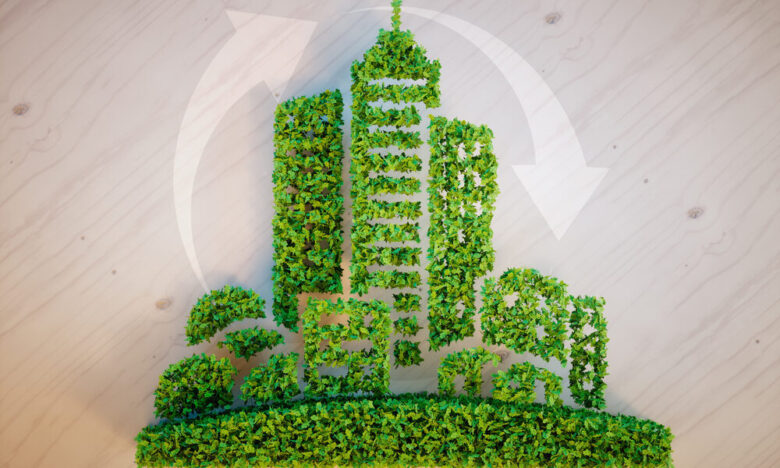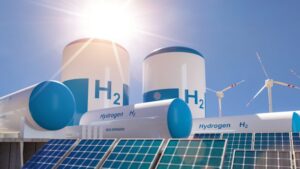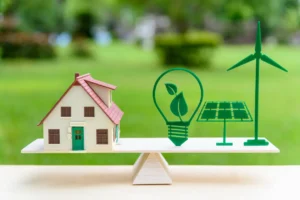Sustainable construction is no longer a niche idea but a crucial component in the global fight against climate change. It involves building and managing structures to minimize environmental impact while maximizing resource efficiency. This approach is aimed at reducing the carbon impact of buildings during their entire lifecycle, from the extraction of raw material to construction, operation, and decommissioning. The world’s growing urban population is driving the need for sustainable and innovative building practices. This highlights the importance of green construction for the future of the planet.
Environmental Benefits
The benefits of green construction are undeniable. Green construction is essential to combating climate change, as buildings account for almost 40% of the global energy-related CO2 emissions. Sustainable buildings incorporate renewable energy like solar and wind, energy-efficient technology, and place a priority on water conservation. They also use eco-friendly materials like recycled concrete, bamboo, and reclaimed wood. This choice reduces the pollution and depletion levels of natural resources. Green building practices actively contribute to cleaner environments, less waste in landfills, and healthier air.
Benefits of Economic Development
Sustainability in construction is not just about being environmentally responsible; it’s also about making good financial sense. Green buildings require an initial investment that may be slightly higher, but they will save you money over the long term through lower operating costs. The use of energy-efficient appliances, improved insulation, and renewable energy systems can drastically reduce utility bills, both for building owners and tenants. Green-certified buildings also tend to attract higher property values, as well as increased rental income. This is because more people and businesses are looking for eco-friendly spaces. Tax breaks, grants, and subsidies are used by governments and municipalities around the world to encourage sustainable practices. Green buildings serve as a testament to the interdependence of sustainability and profitability.
Social Impact
The benefits of sustainable construction go beyond the economics and environment. They also improve human health. Green buildings create more comfortable and healthier spaces for their occupants. The buildings use non-toxic materials and ventilation systems that improve the indoor air quality. The result is improved physical health, productivity, and mental well-being of those who work and live in these spaces. Sustainable construction promotes a stronger community by promoting equity and accessibility in urban planning. Affordable green housing also helps to bridge social gaps, giving more people the opportunity to live in high-quality and sustainable conditions.
Technological Innovations
The latest technologies are pushing sustainable construction to new heights. Smart systems that are integrated into green buildings allow for real-time monitoring of energy consumption, water usage, and overall performance. Smart thermostats, automated light systems, and water-recycling units are some of the advanced technologies. Construction is being revolutionized by innovations like 3D printers, which reduce construction waste and allow for efficient material use. Urban landscapes are being transformed by green roofs, energy-producing façade systems, and vertical gardens. These innovations demonstrate how ingenuity in design can combine sustainability with function. Each technological advancement increases the viability of sustainable construction around the world.
Global Trends and Policies
With sustainability at the forefront of modern development, various global trends and policies have emerged to champion green construction initiatives. Many countries have adopted international protocols such as the Paris Agreement, which underscores the need to reduce carbon emissions in the building sector. Certification programs like LEED (Leadership in Energy and Environmental Design) and BREEAM (Building Research Establishment Environmental Assessment Method) provide benchmarks for developers aiming to achieve sustainability goals. Urban centers are rapidly moving toward net-zero energy buildings as local governments pass stringent regulations promoting renewable energy integration. This collective global effort demonstrates the growing priority placed on green buildings as a response to both environmental and urbanization challenges.
Challenges and Solutions
Despite its promise, sustainable construction is not without its challenges. High upfront costs, limited access to eco-friendly materials, and insufficient expertise among construction professionals often deter broader adoption. Additionally, fragmented policies and inconsistent enforcement standards create further barriers to implementation. However, these challenges are far from insurmountable. Collaborative efforts between governments, private companies, and academic institutions are generating increased awareness and training opportunities for sustainable construction practices. Innovations in technology continue to drive down costs, paving the way for wider accessibility. Furthermore, global funding initiatives are providing the financial support needed to bridge the gap between ambitious sustainability goals and practical application.
Future of Green Buildings
The future of sustainable construction is both exciting and promising. Urban planners and developers are increasingly prioritizing net-zero energy buildings and even carbon-negative designs. Advances in AI and machine learning are enabling predictive resource management, making construction projects more efficient than ever. The trend toward circular construction, where materials are reused and recycled indefinitely, is gaining momentum. These forward-thinking approaches reflect a pivotal shift in how the building industry operates, pointing to a world where sustainability is the baseline standard, not the exception. Green buildings stand to become integral to a global solution for tackling environmental degradation and fostering sustainable urban ecosystems.
Building Toward Green Horizons
Sustainable construction is more than a trend; it’s an essential movement toward a greener, healthier, and more equitable world. From reducing emissions to fostering innovation, green buildings underline a compelling case for rethinking how we design and develop our built environments. For the construction industry, this is not just an opportunity but a responsibility to future-proof our cities against the escalating impacts of climate change. The transition to sustainable practices begins today, with each small step contributing to a larger, collective stride toward a more sustainable future.
FAQs
1. What defines a sustainable building?
A sustainable building minimizes environmental impact by incorporating energy efficiency, renewable materials, water conservation, and environmentally friendly construction practices.
2. Are green buildings more expensive to construct?
While initial costs may be higher, green buildings often yield long-term savings through reduced energy and maintenance expenses. Additionally, government incentives can offset some upfront costs.
3. How do green buildings improve health?
Green buildings prioritize air quality, natural lighting, and non-toxic materials, which contribute to better physical and mental well-being for occupants.
4. Why are green buildings important for urban areas?
Green buildings support sustainable urbanization by reducing energy consumption, managing resources efficiently, and ensuring healthier living and working spaces for city dwellers.




